Australian Goannas, Our Monitor Lizards
The name goannas was given to Australian monitor lizards by the early European settlers. They thought our monitor lizards looked like the South American Iguanas.
On this page you can learn more about Australian monitor lizards:
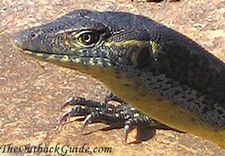
- What do they look like?
- What do they eat?
- How do they live?
- I also have photos of the different species...
- ...and even a few videos to watch.
What Do Goannas Look Like?
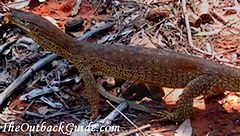
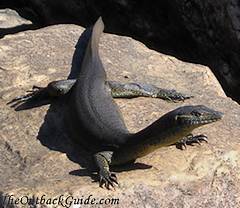
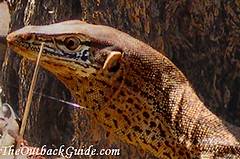
Goannas or monitor lizards are a common sight in Australia.
There are over 20 different species, adapted to different habitats, and interestingly they all look very similar. You can see that in the photos on this page and also in the videos below.
But there is a big difference in their size. The largest Australian monitor lizard, the Perentie, can be over two metres long. Its tiny relative, the short-tailed monitor, reaches all of 20 cm.
All goannas are dark (grey, olive or brown) and most of them show a pattern of lighter coloured (grey, white or yellow) spots, rings, blotches or stripes.
Those patterns vary between the species, but also between younger monitors and adult lizards.
Another common characteristic is the loose skin on a goanna's neck. It makes the neck look bigger than the head. If a monitor lizard feels threatened they can puff up those flaps so they look more dangerous.
What Do Goannas Eat?
Most goannas are rather large for a lizard, and they all have sharp teeth and long claws. Monitor lizards are predators.
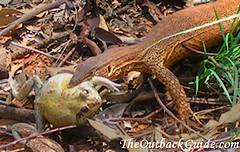
They forage and hunt for lizards, snakes, insects, birds and eggs and even small mammals, and they often dig them out of their shelters and nests.
They're not fussy about what they eat, anything they can grab and overpower will do, and they also eat dead and rotting things.
Like snakes the goannas can unhinge their lower jaw to help them swallow bigger prey. It's impressive to see what size meals they can swallow whole. And if the food is there they will just keep eating. Watching them makes you think they must have bottomless guts. The two videos below illustrate that very well.
The first goanna video shows a baby Lace Monitor. Unfortunately you can't see very well how it catches the other lizard, but the details of how it swallows its prey are great.
The second video features a fully grown Argus Monitor (Varanus panoptes), demonstrating what I said above about how they just keep eating. Watch him devour rat after rat after rat...
Goanna Behaviour
Monitor lizards are mostly terrestrial (except for water monitors). They live on the ground, they find their food on the ground, and they dig an unbelievable amount of holes.
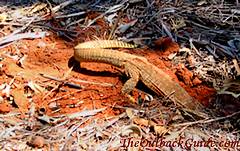
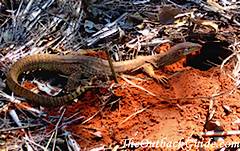
They dig holes when searching for food, they dig holes to lay their eggs in, and they dig huge burrows to shelter in. (Can you imagine the size of the burrow system of a four feet goanna? In your garden? One day I'll break an ankle stepping into one of their holes...)
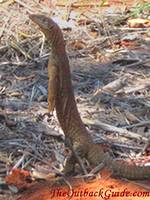
Goannas can rear up on their hind legs.
Sometimes they do it to scare off attackers. They also fight in this way. But mostly I see them stand up when they hear/notice anything suspicious, to look around for threats (in those cases that would have been me...).
Goannas can run very fast over short distances, sometimes using their hind legs only. They are very good tree climbers, and that is what they will often run for.
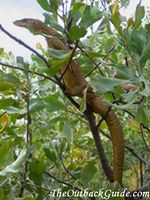 You may have heard stories that if there aren't any trees the goanna will use you instead and tear shreds of you. (Aussies love to scare tourists with horror stories about what our animals might do to you.)
You may have heard stories that if there aren't any trees the goanna will use you instead and tear shreds of you. (Aussies love to scare tourists with horror stories about what our animals might do to you.)
If the goanna has room to run it'll run away from you. Of course, if you corner it or try to catch and wrestle it you might find out just how sharp these teeth and claws really are.
Goannas get used to humans quickly. All my photos on this page were taken very close to my veranda. I have a few sand monitors living here, and they don't take much notice of me any more...
If you travel anywhere in the Australian Outback you are highly likely to see goannas in the wild. They are most active during the day, and many goanna species like to hang around water courses and rock pools, lazing and sun basking, just like we do...
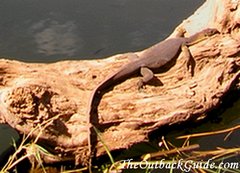
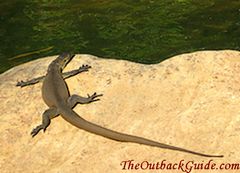
Some common goanna species
The Komodo Dragon
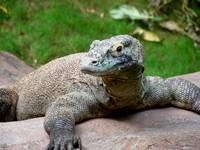
The best known monitor lizard is the biggest species, the Komodo Dragon. Interestingly, there is also a dragon family of lizards in Australia (the Agamidae), but the Komodo Dragon isn't a dragon, it's a monitor (family Varanidae). You can see the Komodo Dragons in Australia, but only in zoos. They are not native to Australia.
The two zoos that display Komodo Dragons are the Australia Zoo and the Taronga Zoo.
The Perentie
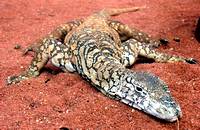
The Perentie (Varanus giganteus) is the biggest Australian monitor lizard. It can grow to over two metres. Perenties live in the dry regions of inland Australia and particularly like rocky country. Perenties look, eat and live just like I described above for goannas in general. Something I didn't mention is hibernation. Perenties (and other goannas) hibernate during the cold time of the year, from about May to August.
Despite its huge the size the Perentie is a rather shy lizard, and it is not a common sight. But some people get lucky. Here is a page that has some beautiful photos of a wild Perentie.
The Water Monitor
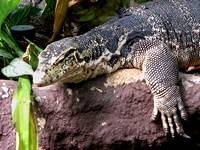
Water monitors (Varanus salvator) are the second biggest lizards in the world, but they aren't native to Australia. The Australian water monitors are smaller. There are two kinds, the Mertens Water Monitor (Varanus mertensi), and the Mitchell Water Monitor (Varanus mitchelli).
The Mertens Water Monitor, which is quite common, grows to 4 feet in length.
The uncommon Mitchell Water Monitor is smaller, about two and a half feet (70 centimetres). Both live in northern Australia near creeks, swamps, lagoons and other bodies of water.
Water monitors are excellent swimmers and can stay under water for several minutes. Most of their food comes from the water - fish, frogs, crabs, shrimps and similar - but they also find some on land, like reptile eggs and insects.
Unlike other goannas a water monitor will not run, but rather slide into the water when disturbed or threatened.
The Sand Monitor
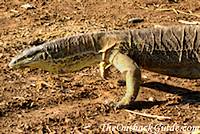
The Sand Monitor, sometimes called Goulds Monitor or Goulds Goanna, is the most common Australian goanna. Another name sometimes used for them is Racehorse Goanna. There are several species and subspecies, and there is some taxonomic confusion, so I'll just keep it simple and throw them all together as Sand Monitors.
These large goannas are plentiful just about anywhere, except for the extreme south and south east of Australia. Sand monitors are the most terrestrial of all goannas. They only climb trees to escape trouble. Sand monitors are equipped with longer legs and bigger feet than most goannas and are particularly good diggers. They seem to get a lot of their food from below the ground.
And here is an interesting tidbit of information regarding the goannas in the north. One of their favourite food sources is crocodile eggs. In fact, over 90% of crocodile eggs never hatch due to the insatiable goannas. Now that the toxic cane toads are wiping out goannas across the north the crocodile population is expected to explode. Let's see...
The Lace Monitor
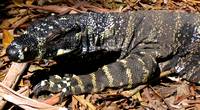
The Lace Goanna or Lace Monitor (Varanus varius) is the second largest Australian goanna and can grow to two metres. Its range is restricted to eastern Australia, where it is found from Melbourne in the far south all the way up to Cape York in the north.
If a Lace Monitor feels threatened it will definitely race for the nearest tree. They generally spend a fair bit of their time in large trees, so much so that some people call them tree goannas. They are believed to eat more birds and eggs than other goannas. But they are good runners, burrowers and swimmers as well. Like other goannas they hunt and forage for their food on the ground.
Read about other Australian Lizards | Return to top
All Australian Animals | Australian Outback Animals
Return from Australian Goannas to Outback Australia Travel Guide home page
The photos in the common species section (except for the Sand Monitor) are from Wikipedia and are under GNU Free Documentation License.





